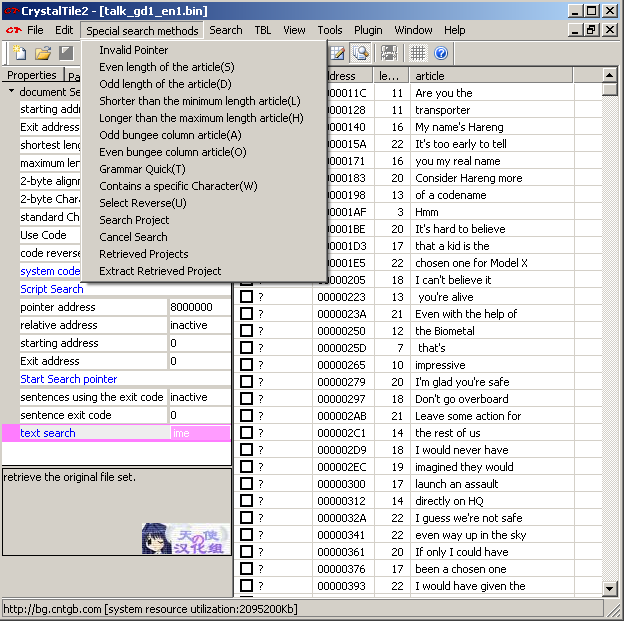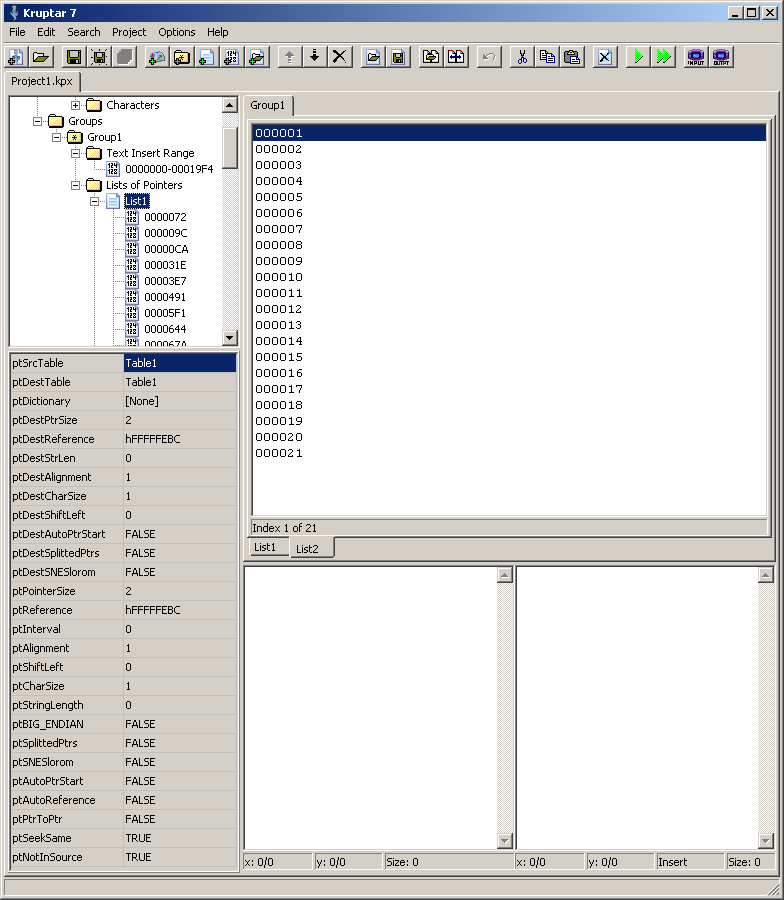3.6 Text extraction and insertion
Knowing what text is, how it is encoded and how any markup happens is all well and good but for anything beyond a trivial character replacement it gets to be troublesome to edit things in your hex editor unless you are very fortunate and have a scripting engine or something similar. Equally your translation team/programs might not appreciate having to deal with programming style arrangements and will much prefer to have something that can at least be edited in a general purpose editor.
3.6.1 Text extraction
Even with a somewhat more complete table many ROM images might not have their text easily extracted to a plain text file thanks to things like markup and placeholders; even simple things like the section has no new lines/end of section marker how most text editors understand it can trouble things. It is for this reason that custom programs are often made to support a given game/series rather than dealing with a simple script dump. However a simple script dump is quite nice to have on occasion and with a bit of thought can be made so as to allow things to be brought back into the text at a later date with a little bit of effort rather than require a full manual rework.
Technically table files do support a line, string and section break parameter (tabular has the ability to add them) but whether your extraction tool supports them is a different matter. Also recall that not all games use them and might use pointers or fixed length sections instead.
To this end it can be quite useful to replace such concepts with things you can edit back in later. Although there are exceptions the vast majority of ROM images will use a binary format for things like line breaks.
The two main approaches to this are XML style markup and (massive) flags.
XML is a programming language after a fashion and allows you to define a simple dataset but here the idea of using < and > around custom strings to indicate concepts in a fashion like <newline>, <end of paragraph> and later on proper markup like <bold> holds a bit of appeal and for the most part games will not tend to use such concepts (although do check). If you have these then they allow for a simple search and replace to do the job of a more complex tool. Not to mention you can go really far and actually use proper XML with a parser you built for it.
Flag and massive flag is kind of like the XML stuff above but instead the actual hex representation of things will be used so you can replace more easily.
A nice example might be that in basic editors in windows new line in text is indicated by 0D0A hex (other operating systems like Apple (0D) and Unix systems (0A) are different but they will tend to support the windows version as well), here you might make it so the original end of line is indicated with a symbol like # or @ (one not likely to be used in the game), has an extra line added in the actual hex (or not if you prefer that) and then you can replace easily in a hex editor at the end. Massive flag just uses a long run of symbols so you can be sure it is not part of the normal game.
Crystaltile2 scripting window One of the earlier projects of the original author of Crystaltile2 was a tool known as Crystalscript which aimed to unite table support, programming approaches and some more linguistic/language driven approaches to text extraction. Its functionality more or less made it into crystaltile2 and is available in the little discussed text editing window.
This is where the hastily translated (with the aid of some machine translation) nature of crystaltile2 brings the process down a bit.
The general idea is after creating a table and telling it to use it on the pulldown menu (if necessary - remember Crystaltile2 supports a wide range of known encodings) you open the file in this mode.
After this you can click on the search pulldown menu and press “Ambassador” search which acts much like a strings search from a standard hex editor. After this you can narrow down your selection with one or more of the special search methods (bungee column means aligned here) and once you have the files selected you can press “Extract Retrieved Project” or use the similar commands on the edit menu.

PIC
Conventional text extraction Despite the potential troubles enough games have done things in similar ways that some programs have been made that can help facilitate text extraction. The two most popular tools are Cartographer and Kruptar 7 although romjuice (one of the earlier tools) remains quite popular as well.
Cartographer Romhacking.net download
A command line only tool which you feed file and a commands list (which includes a table) before it spits out a fairly nicely formatted text dump. The included readme contains full usage and a few examples. Most of it is fairly straight forward but it does also support pointers of various types (though no explicit command to support GBA games).
If your GBA game sports some new line/end of section tokens those might be worth using but if you are using pointers the addition of a 08 or similar at the start of the value (it does support an endianness swap) might make things tricky. You can attempt to use the “#POINTER SPACE” command to skip bytes and you might try using the relative pointers option but a large negative value might not work well. Failing that a search and replace or better 32 bit bitwise AND with 00FFFFFF (FFFFFF00 if you account for endianness) across the pointer field will allow you to get things done; workarounds like this are commonplace if you have to use premade tools and having the ability to do them is usually a sign of a good hacker.
Kruptar 7 Romhacking.net download
A newer graphical tool (or at least the current rewrite is fairly new) and one that interfaces with the table making tool Oriton fairly well (they come from the same hacking group/site). It does also have some editing and insertion abilities as well as table editing.
Pointer abilities as seen on the picture are some of the best around and it can support plugins written in turbo pascal.

PIC
3.6.2 Text insertion
Once you have found, decoded, extracted and altered/translated the text comes inserting it back into the ROM. Even the basic text edit can take some thought to get it back into the ROM and if you had to change some things to make it more amenable for a general text editor or your team it can get worse.
After this you also have to recalculate the pointers but that is a different matter. You might also have the even more annoying task of recalculating pointers and editing the ROM binary if your text was eventually found among the instructions in the game binary or overlays, something several DS projects that initially seemed quite easy have encountered.
Even more so than the detailing of how to find files/desired data or creating tables the insertion of text in many tutorial documents amounts to “grumble grumble, just do it” and moving on. This is not without reason as there are a great many things that can trip it up and although some ostensibly general purpose tools do exist they are either impossibly basic and useful for only a few things (or will do it but extensive manual prodding beforehand), nearly a programming language unto themselves or very game specific. Speaking of game specific if you can then it is generally best to get it done that way as there are so many methods games can use for text.
Still you are going to want to know four things
- What, if any, markup and placeholders are available, used and what the extraction stage might have left them as.
- What, if any, layout, section end and line wrapping commands/markup are available.
- What, if any, restrictions you have on line width (note that you might also have restrictions not immediately obvious if the text is used elsewhere with things like flashback sequences, chapter introduction sections and conversation recounting methods).
- What, if any, limits on text size you have from the perspective of the file format limits or, often more troubling, the memory space limits.
If you have changed the markup from a binary one to one more resembling HTML, XML or a forum markup (or used the flag technique) you need to change it back. You should also take note of your character encodings as games and computers can do things differently. This can be simple things like British English still uses the different types of quote marks (inverted quotes) which will have different encodings and American English (also the default setting for most games) will tend to use the single style of quote (typewriter quotes) or indeed eschew double quotes in favour single quotes (which appear the same as apostrophes and a game might use the same character for the different types of punctuation). Also if you are not careful a given font on a computer will confuse such things as far as the on computer representation goes but leave them encoded differently, not to mention the related problem of if a game uses a full stop as a section end (there is often a proper section end command but not always) and having the quotes outside the punctuation (again differences in types of English grammar appear here).
On the subject of character encodings it is usually best to match the original encoding with the output; several games have used shiftJIS for parts and regular ASCII for others (even merging them together within the same string) and will complain a lot if it is not that way when it it comes to being run, however this is one thing that is definitely worth checking out/experimenting with as it can save some space.
Other than that it should be fairly easy to determine if you have things of legal lengths (although in practice you would probably have someone act as a script editor for this in a big project).
Conventional text insertion Much like text extraction there have been attempts to make general purpose tools. They are quite often limited in ability or so complex as to be nearly a programming language unto themselves but it is worth knowing about Atlas. Atlas is something of a standard in general purpose ROM hacking text insertion and most extraction tools aim to have a measure of compatibility with it, not to mention most other insertion tools will copy part of the functionality as well. Equally even if the encoding has not been changed it is not uncommon for there to be tables for text extraction and modified versions thereof for text insertion.
It is a script based inserter where the script type is defined. The download includes both source code to allow for modifications (although the program itself does have limited plugin support) and a manual with several worked examples on usage. In many ways it is aimed at/has provisions for the SNES and similar consoles with memory mapping but can be made useful for the file level pointers as seen in many DS formats.